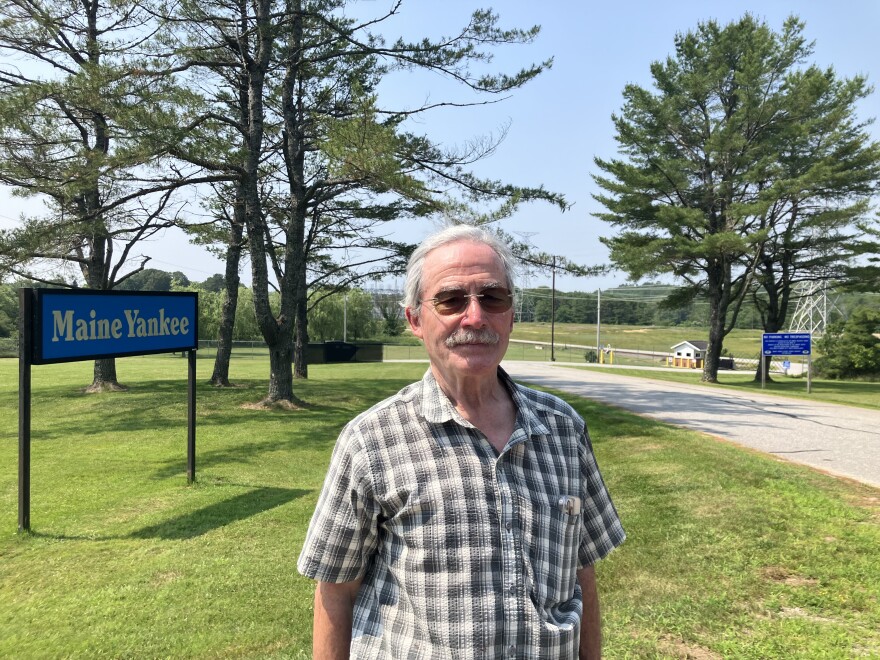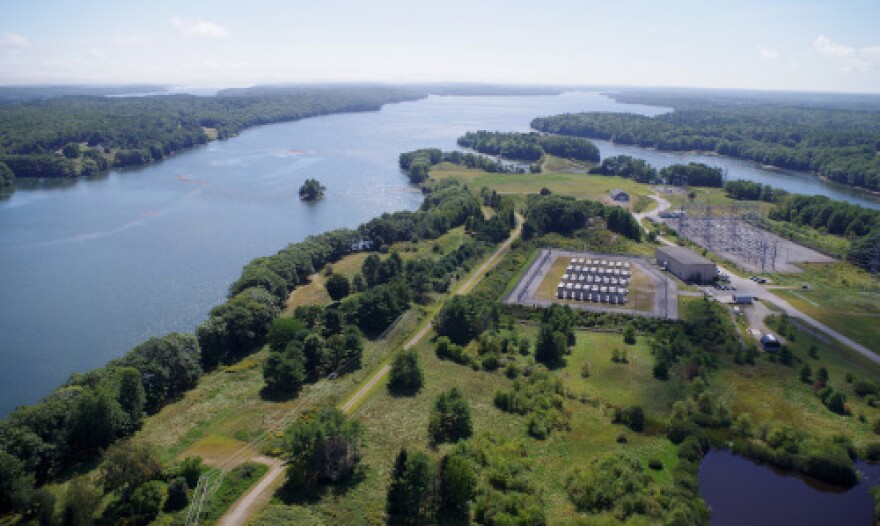The remains of the Maine Yankee nuclear plant in Wiscasset are protected by a tall chain link fence topped with razor wire and a checkpoint manned by armed guards.
Surrounded by trees and fields, towering pylons from an electric substation are some of the only infrastructure still visible from the road leading down to Bailey Point.
But Don Hudson says 30 years ago it was a completely different scene: A huge dome covered a reactor that cranked out a third of Maine's power, the largest single source of electricity in the state.
"That concrete dome would have dwarfed the other buildings which after a while you would have picked up," Hudson said.
"The adjacent buildings that housed the spent fuel pool and all the apparatus needed to generate electricity," he added.
Back then Hudson was working with the Chewonki Foundation an environmental nonprofit located across a narrow coastal channel from the plant.
"As a young man, I was opposed, strongly opposed to nuclear power, largely because it was right next door to the place I worked," Hudson said.
He remembers the plant opening in 1972. Twenty-four years later safety concerns and expensive repairs shuttered Maine Yankee. Hudson chairs the community advisory panel group established first to help decommission the plant and now to advocate for removing fuel waste from the site.
And all these decades later, he's still working to find a final resting place for 540 tons of spent nuclear fuel still stored in specialized concrete tubes at the former plant. Without a national strategy to collect and manage America's nuclear waste, Bailey Point will likely remain a storage facility that costs about $10 million a year.
And under current rules, the material will have to remain secure for 10,000 years, Hudson said.
"If we're going to use nuclear power from here into the future, we need to resolve this issue with high level radioactive waste," Hudson said.
Decades after reactor disasters at Chernobyl, Three Mile Island and Fukushima, Americans' appetite for nuclear power is on the upswing according to recent polling from the Pew Center and Gallup.

Refocused attention on nuclear is being driven by tech companies hungry for electricity to fuel data centers and startups developing "small modular reactors" that could be deployed faster than traditional power plants.
Meanwhile, both the Trump and Biden presidential administrations have pushed policies aimed at encouraging new nuclear generation.
"Whether you're looking from the federal level or the state level, or you're the industry, or at the local level, I think you there are a lot of people that see the potential that new nuclear can provide that just other generation sources can't," said Kristy Hartman, a spokesperson for the Nuclear Energy Institute, an industry trade group.
Nuclear plants are incredibly costly and take years to get approved and constructed.
But Hartman said the payoff is worth it — enormous amounts of 24/7 electric power made without climate-warming pollution.
That attribute could be attractive to states like Maine, with goals to use completely clean energy in the near future, Hartman said.
States "have these mandates and they have these decarbonization goals in particular and they are not going to reach the finish line with just the renewables that they originally set," Hartman said.
About a quarter of New England's electricity comes from nuclear reactors in New Hampshire and Connecticut.
But Jamie Dickerson, senior director of climate and clean energy programs at the Acadia Center, doubts nuclear will make significant inroads in the region.
"Most of the modeling that we have reviewed largely suggests a future where solar, wind and batteries are really dominating the generating resource mix well into the future," Dickerson said.
Even as New England states see prospects to rapidly build out offshore wind resources in the face of market forces and political obstruction, Dickerson still thinks nuclear will complement, not displace, renewable generation.
And Jack Shapiro from the Natural Resources Council of Maine said new reactors have a track record of construction delays and massive cost overruns.
"Building new nuclear will not occur in time to meaningfully contribute to emissions reductions, while renewables are being rapidly deployed today," Shapiro said in testimony to the Legislature this winter.

Maine lawmakers rejected two bills aimed at smoothing the way for nuclear generation in the 2025 legislative session. But a third bill, to request informational bids for small modular reactors, was carried over for more debate next year.
Patrick Woodcock, CEO of the Maine Chamber of Commerce and a former energy official in Maine and Massachusetts, said all options should be considered to bring down escalating electric costs.
But he doesn't think it is realistic to expect a new reactor in Maine in the near future. Any nuclear development requires approval from a statewide referendum, which could make developers think twice, Woodcock said. Plus, the state's electric market is likely too small to justify the massive expense of building a new plant.
But regional projects to maintain or expand New England's remaining reactors could be worth considering, Woodcock added.
"Ultimately this comes down to economics," Woodcock said "Does this make sense for ratepayers? Does this make sense for our load growth trajectory? Ultimately that comes down to a specific proposal and we are a long way from seeing that in New England," he added.
Back in Wiscasset, Don Hudson says he got more comfortable with Maine Yankee after seeing the plant in operation. But without a national strategy to manage spent fuel, he's not convinced new reactors are a solution for future electric demand.
"This is a serious issue and frankly if it doesn't get resolved soon people should stop talking about nuclear power 2.0," Hudson said. "It just doesn't make any sense."



